Tea Sweets and Offerings
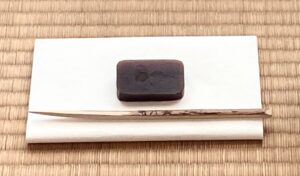
This is a standard presentation of sweets to a guest, informally as well as at a formal cha-kai, 茶会, tea-gathering. The sweet and the pick are presented by the host, tei-shu, 亭主, house-master, and the guest, kyaku, 客, guest, uses her or his own kaishi. The kuromoji is a lasting souvenir.
In certain more ‘formal’ Tea presentations a greater number of o-ka-shi, お菓子, hon.-sweet-of, sweets are offered. Some presentations traditionally present two, three, five, and seven sweets. These are offered to guests in individual boxes called fuchi-daka, 縁高, edge-high, which are borrowed from Buddhist meal service. The types of sweets, of which there are an infinite variety in Japan, can be specific. The essential ‘sweets’ are influenced by Shintō offerings, presented on san-bō, 三方, three-directions, and san-bō, 三宝, three-treasures. The treasures are rice, salt, and water.
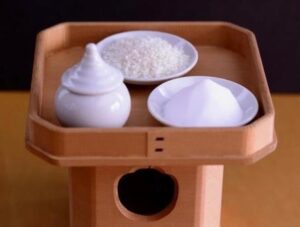
Shintō offerings of rice, salt, and water in a vessel with conical top, placed on a san-bō, 三宝, three-treasures.
There are openings in the base of the sanbō that may represent the three offerings. These three things are offerings to deity and should not be eaten. Some foodstuffs may be placed before a deity to bless the foods, and these are to be eaten.
The toji-me, 綴じ目, join-eye, shō-men, 正面, true-face, of the tray is on the opposite side compared to the base tojime, so that there are two tojime and two shōmen.
The Shintō san-bō offering stand has two ‘fronts’ shōmen one for the tray, and one for the supporting base. The shōmen of the tray has the rice toward the spirit. The shōmen of the supporting base has one of the three openings facing the celebrant. It is apparent that the sweets offered to the guest are in the manner of the offerings, with the rice at the front. In this way, the guest is metaphorically elevated to the level of Spirit.
Teishu
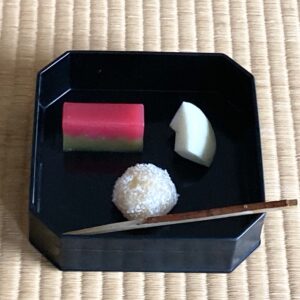
Shōmen
Kyaku
Spirit
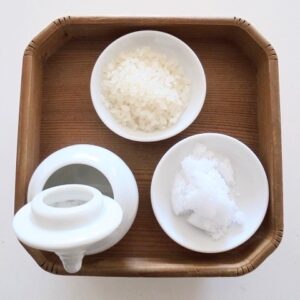
Celebrant
Celebrant
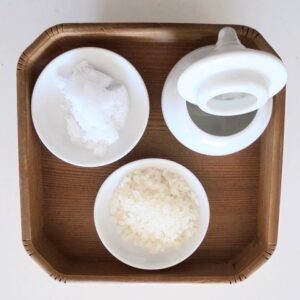
Spirit
The three okashi are presented by the teishu to the guest with the principle sweet at the front, shō-men, 正面, true-face.
The Shintō offerings are placed on the tray with the rice toward the front, the salt placed back left, and the water is placed back right. These products are manifest in the three sweets served in Chanoyu.
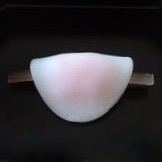
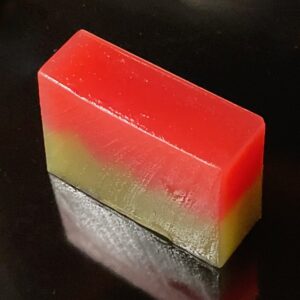
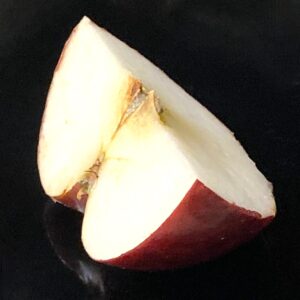
Nama-ga-shi, 生菓子, raw-sweet-of, Hana-bira mochi, 花弁餅, flower-petal mochi, by Fuku-ju-dō Hide-nobu, 福壽堂秀信, Fortune-longevity-hall Excel-truth. The mochi or sweets that are regarded as the omo-ga-shi, 主菓子, main-sweet-of.
Sao-mono, 棹物, block-thing, yōkan, preserved, a trait of salt (past): ‘Ake no Ryū’, 明けの龍, Dawn’s Dragon, by Toraya, とらや, ‘Tiger-house’, Kyōto.
Mizu-ga-shi, 水菓子, water-sweet-of, fresh fruit (future): apple. Note the reflection in the mirror-finish, black-lacquered surface.
The three different sweets are manifestations of the three Shintō offerings: rice, salt, water.
The omo-ga-shi, 主菓子, main-sweet-of, is made or acquired just before it is served at the Tea presentation. The sweet represents Now. It manifests the offering of rice. The yōkan, is preserved, and can be kept for some time, and therefore represents the Past, and manifests the preservative aspect of salt. The fresh fruit, called mizu-ga-shi, 水菓子, water-fruit-of, by its name alone represent Water, and with its seeds is identified with the Future.
The sao-mono when seen from a particular angle, as pictured, the outline of the block has six sides and six corners. The number six is symbolic of Infinity in Time. The fuchidaka box has eight sides, which is symbolic of Infinity in Space.

